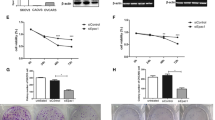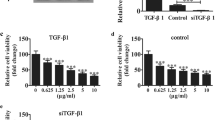Abstract
Epithelial ovarian cancer (EOC) is the leading cause of cancer-related death among all the gynecological malignancies of the female genital system, and its incidence and mortality rates continue to rise. B-cell translocation gene 3 (BTG3) plays an important role in the occurrence and development of numerous cancers. However, the role of BTG3 in EOC remains poorly understood. In this study, we aimed to investigate the biological role and potential molecular mechanism of BTG3 in EOC. We found that BTG3 protein expression was significantly lower in human EOC cell lines. Next, BTG3 upregulation by transfection with pcDNA3.1-BTG inhibited cell proliferation and invasion but promoted cell apoptosis in 2 human EOC cell lines, SKOV-3 and HO-8910 cells. In addition, BTG3 knockdown by small interfering RNA promoted cell proliferation and invasion, but inhibited cell apoptosis in 2 human EOC cell lines, SKOV-3 and HO-8910 cells. Importantly, several proteins, including phosphorylation serine/threonine kinase (p-AKT), phosphorylated glycogen synthase kinase 3β (p-GSK3β), and β-catenin, were markedly decreased by BTG3 upregulation, whereas increased by BTG3 knockdown. Taken together, the results of our study suggest that BTG3 overexpression could inhibit cell proliferation and invasion and promotes cell apoptosis in EOC cell, possibly by regulating the AKT/GSK3β/β-catenin signaling pathway, providing novel insights into the treatment of EOC through BTG3 overexpression.
Similar content being viewed by others
References
Samrao D, Wang D, Ough F, et al. Histologic parameters predictive of disease outcome in women with advanced stage ovarian carcinoma treated with neoadjuvant chemotherapy. Transl Oncol. 2012;5(6):469–474.
Jayson GC, Kohn EC, Kitchener HC, et al. Ovarian cancer. Lancet. 2014;384(9951):1376–1388.
Rankin EB, Fuh KC, Taylor TE, et al. AXL is an essential factor and therapeutic target for metastatic ovarian cancer. Cancer Res. 2010;70(19):7570–7579.
Cliby WA, Powell MA, Al-Hammadi N, et al. Ovarian cancer in the United States: contemporary patterns of care associated with improved survival. Gynecol Oncol. 2015;136(1):11–17.
Gadducci A, Cosio S, Zola P, et al. Prognostic factors and clinical outcome of patients with recurrent early-stage epithelial ovarian cancer: an Italian multicenter retrospective study. Int J Gynecol Cancer. 2013;23(3):461–468.
Matsuda S, Rouault J, Magaud J, et al. In search of a function for the TIS21/PC3/BTG1/TOB family. FEBS Lett. 2001;497(2-3):67–72.
Deng B, Zhao Y, Gou W, et al. Decreased expression of BTG3 was linked to carcinogenesis, aggressiveness, and prognosis of ovarian carcinoma. Tumour Biol. 2013;34(5):2617–2624.
Ren XL, Zhu XH, Li XM, et al. Down-regulation of BTG3 promotes cell proliferation, migration and invasion and predicts survival in gastric cancer. J Cancer Res Clin Oncol. 2015;141(3):397–405.
Chen X, Chen G, Cao X, et al. Downregulation of BTG3 in non-small cell lung cancer. Biochem Biophys Res Commun. 2013;437(1):173–178.
Du Y, Liu P, Zang W, et al. BTG3 upregulation induces cell apoptosis and suppresses invasion in esophageal adenocarcinoma. Mol Cell Biochem. 2015;404(1-2):31–38.
Lin TY, Cheng YC, Yang HC, et al. Loss of the candidate tumor suppressor BTG3 triggers acute cellular senescence via the ERK-JMJD3-p16(INK4a) signaling axis. Oncogene. 2012;31(27):3287–3297.
Cheng YC, Chen PH, Chiang HY, et al. Candidate tumor suppressor B-cell translocation gene 3 impedes neoplastic progression by suppression of AKT. Cell Death Dis. 2015;6:e1584.
Di J, Huang H, Qu D, et al. Rap2B promotes proliferation, migration, and invasion of human breast cancer through calcium-related ERK1/2 signaling pathway. Sci Rep. 2015;5:12363.
McGarry T, Veale DJ, Gao W, et al. Toll-like receptor 2 (TLR2) induces migration and invasive mechanisms in rheumatoid arthritis. Arthritis Res Ther. 2015;17:153.
Ou YH, Chung PH, Hsu FF, et al. The candidate tumor suppressor BTG3 is a transcriptional target of p53 that inhibits E2F1. EMBO J. 2007;26(17):3968–3980.
Gou WF, Yang XF, Shen DF, et al. The roles of BTG3 expression in gastric cancer: a potential marker for carcinogenesis and a target molecule for gene therapy. Oncotarget. 2015;6(23):19841–19867.
Geiger TR, Peeper DS. Metastasis mechanisms. Biochim Biophys Acta. 2009;1796(2):293–308.
Chin YR, Toker A. Function of Akt/PKB signaling to cell motility, invasion and the tumor stroma in cancer. Cell Signal. 2009;21(4):470–476.
Qiao M, Sheng S, Pardee AB. Metastasis and AKT activation. Cell Cycle. 2008;7(19):2991–2996.
Agarwal E, Brattain MG, Chowdhury S. Cell survival and metastasis regulation by Akt signaling in colorectal cancer. Cell Signal. 2013;25(8):1711–1719.
Wang CY, Tsai AC, Peng CY, et al. Dehydrocostuslactone suppresses angiogenesis in vitro and in vivo through inhibition of Akt/GSK-3beta and mTOR signaling pathways. PLoS One. 2012;7(2):e31195.
Luo J. Glycogen synthase kinase 3beta (GSK3beta) in tumorigenesis and cancer chemotherapy. Cancer Lett. 2009;273(2):194–200.
Zeng J, Liu D, Qiu Z, et al. GSK3beta overexpression indicates poor prognosis and its inhibition reduces cell proliferation and survival of non-small cell lung cancer cells. PLoS One. 2014;9(3):e91231.
Gough NR. Focus issue: Wnt and beta-catenin signaling in development and disease. Sci Signal. 2012;5(206):eg2.
Arend RC, Londono-Joshi AI, Straughn JM, Jr Buchsbaum DJ. The Wnt/beta-catenin pathway in ovarian cancer: a review. Gynecol Oncol. 2013;131(3):772–779.
Yan X, Lyu T, Jia N, et al. Huaier aqueous extract inhibits ovarian cancer cell motility via the AKT/GSK3beta/beta-catenin pathway. PLoS One. 2013;8(5):e63731.
Author information
Authors and Affiliations
Corresponding author
Rights and permissions
About this article
Cite this article
An, Q., Zhou, Y., Han, C. et al. BTG3 Overexpression Suppresses the Proliferation and Invasion in Epithelial Ovarian Cancer Cell by Regulating AKT/GSK3β/β-Catenin Signaling. Reprod. Sci. 24, 1462–1468 (2017). https://doi.org/10.1177/1933719117691143
Published:
Issue Date:
DOI: https://doi.org/10.1177/1933719117691143




